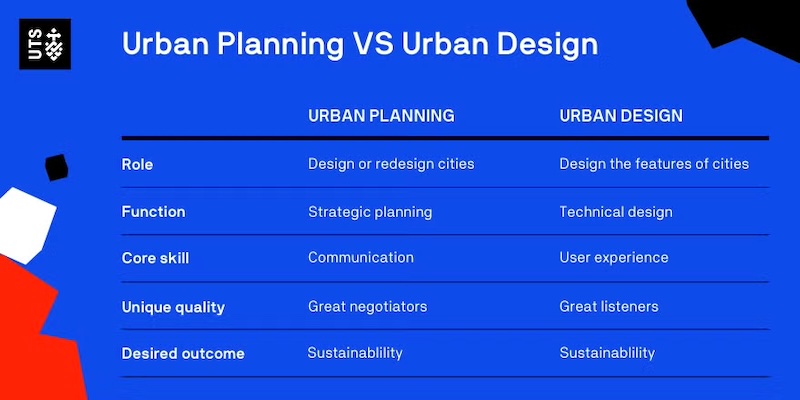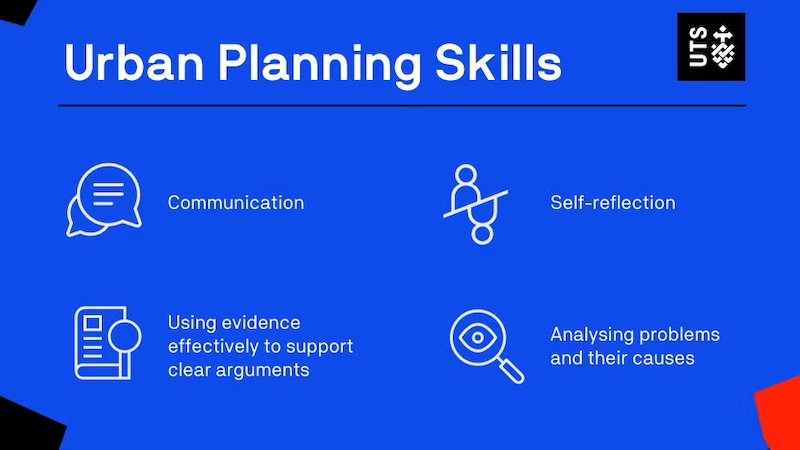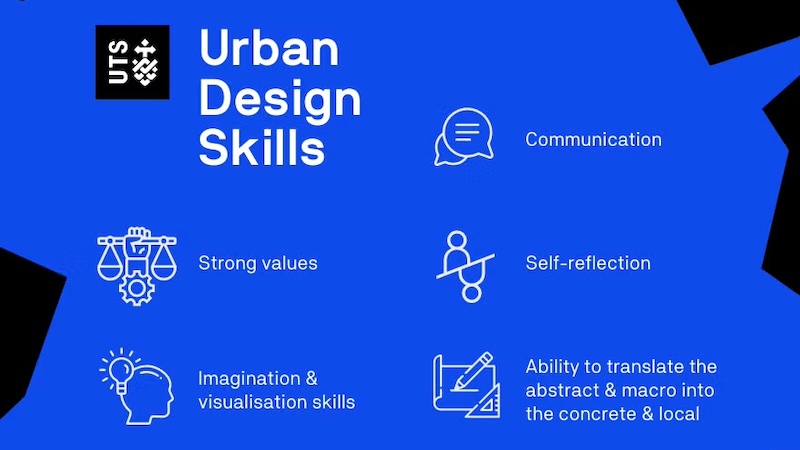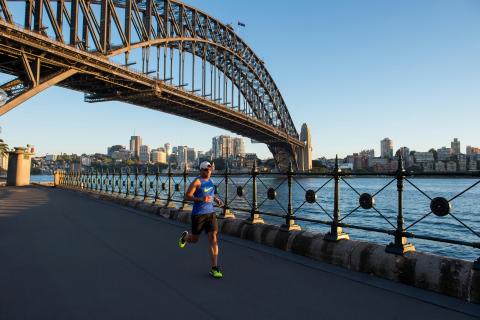What’s the difference between urban planning and urban design?


There’s a good reason why we have trouble telling the difference between urban planning and urban design – and that’s because they both have the same priorities.
At least, that’s the experience of Professor Heather MacDonald, previously Deputy Dean in the Faculty of Design, Architecture and Building at UTS.
“The urban designers I know are passionate about the same things planners are passionate about – how to build sustainable, just, and socially connected public spaces,” says MacDonald.
How they achieve those goals is where we find the real differences between urban planners and urban designers.
Dr Gabriela Quintana Vigiola is a senior lecturer in planning at UTS and was previously the Course Director of the Master of Urban Planning and the Master of Urban Design. She explains that urban design and urban planning are different sides of the same coin.
“Urban design focuses more on the shape and form of spaces, as well as people’s experiences of a place. Urban planning focuses on how these spaces function in an effective way to make people’s lives better. Both disciplines focus on the sustainability, adaptability and safety of cities – which is why both disciplines go hand in hand.”
What is urban planning?
Urban planning is a strategic high-level job with the purpose of shaping cities, often involving a variety of stakeholders. In the modern era, sustainable urban planning is increasingly important.
“Planners are passionate about cities in general and how they evolve and function. They aim to make the world a better place,” says Dr Vigiola.
Bill Hames is an urban planner who’s recently been reflecting on his role in the city planning of Perth’s satellite city, Joondalup.
“It’s a bit frightening, because you’re going to put things onto paper that are going to become reality,” says Hames.
Fast-forward 30 years and the line that Hames drew on a piece of paper and called Grand Boulevard is living up to its name as the main artery of a city with a great quality of life.
It was a future that Hames could see as an urban planner, despite its humble beginnings as undeveloped open space with little land use and one tiny road. This macro view of the urban environment is what defines urban planning.
Examples of successful urban planning
Another example of Perth’s successful urban planning initiatives is the redevelopment of Elizabeth Quay, a vibrant waterfront precinct that’s transformed the city’s riverfront.
Completed in 2016, this project aimed to reconnect the city with the Swan River, creating a dynamic space for residents, businesses and tourists.
The redevelopment included a mix of residential, commercial and public spaces with iconic features, such as the stunning Elizabeth Quay Bridge, the public art piece Spanda and the open-air Island Playground.
Elizabeth Quay was designed with a focus on accessibility, sustainability and community engagement.
The area hosts various events, markets and festivals throughout the year, making it a lively hub for social interaction and cultural activities. It’s also improved pedestrian and cyclist connectivity between the city centre and the river, encouraging more active transportation options.
The initiative has successfully boosted Perth’s appeal as a tourism and business destination, significantly contributing to the local economy and providing a blueprint for future projects that aim to revitalise urban spaces in a way that benefits both residents and visitors.
What is urban design?
While similar to urban planning, urban design is a more hands-on role that takes care of the design of the elements that make up cities – building forms, streets, green spaces, community areas and more.
“Urban designers tend to be really good observers of how details of the physical environment produce an overall experience for users,” says MacDonald.
“They can articulate how design elements work together – such as a strip of vegetation between a footpath and the road – or don’t work, like a narrow footpath on a busy road.”
Margie McKay works for the City of Melbourne, leading a team of urban designers who are working on the Melbourne Transport Strategy 2030. They provide design advice and are “involved in the strategy and policy end of the design scale”.
The strategy aims to create an efficient, safe and sustainable transport network to cater for population growth.
“One of the strategy’s key directions is about supporting the walking economy. Walking is the most spatially efficient form of transport, followed by public transport and cycling, and this has driven the strategy’s priorities and framing,” says McKay.
Examples of successful urban design
There have been many successful urban design projects completed in Melbourne, such as the revitalisation of Federation Square.
An iconic public space in the heart of Melbourne, Federation Square was designed to be a cultural and social hub, blending contemporary architecture with public spaces to create a vibrant meeting point for residents and visitors.
Federation Square's design features open plazas, laneways and buildings with unique geometric facades, making it one of Melbourne’s most recognisable landmarks. It focuses on accessibility, versatility and engagement, providing various public spaces for events, exhibitions and everyday activities.
It includes key cultural institutions like the Ian Potter Centre, a joint venture between the National Gallery of Victoria (NGV) and the Australian Centre for the Moving Image (ACMI), along with restaurants, cafes and outdoor seating areas that enhance the visitor experience.
The space hosts hundreds of events annually, from large-scale public gatherings to intimate community activities, making it a dynamic part of city life.
The success of Federation Square lies in its ability to adapt and serve as a flexible, inclusive space that reflects Melbourne’s diverse culture.
What is urban development?
To fully understand urban planning and urban design, it’s also important to understand another concept: urban development.
Urban development is the process of enhancing and expanding urban areas to accommodate population growth, improve living conditions and support economic activities.
This includes building infrastructure like roads, utilities, housing and commercial spaces. It also involves implementing policies and investments that promote sustainable city growth. The primary goal of urban development is to create functional, livable and economically viable urban environments by addressing social, economic and environmental needs.
In practice, urban development differs from urban planning and urban design in its scope and focus.
Urban planning is concerned with the strategic and regulatory aspects of city growth, including land use planning, zoning and long-term policies that guide how cities develop. It sets the framework for how space is used and ensures that development occurs in an orderly, sustainable manner.
Urban design focuses on the detailed physical and aesthetic aspects of urban spaces, such as streets, parks and public areas, aiming to create attractive, accessible and user-friendly environments.
Urban development, on the other hand, involves the overall growth of a city, including planning and physical design. It mainly concentrates on implementation and the economic aspects of urban expansion, integrating urban planning strategies with creative and functional urban design considerations.
What’s the difference between urban planning vs urban design?
While urban planners and urban designers work on projects with the same desired outcome of sustainability, they’re separate roles. Which suits you best will depend on your skills and personal interests.
To become an urban planner, you’ll need great communication skills, including the ability to be a great negotiator.
Urban design requires excellent technical design skills. You’ll also need great communication skills, especially listening to really understand the user experience.
What urban planning and urban design will always share in common is the desired outcome of sustainability. Together they create urban spaces that sustain people and the environment.
Whichever side of the coin you choose, you can improve your communication skills, upgrade your qualifications and advance your competitive advantage with the right master’s degree.

Urban planner vs. urban designer: Which is right for me?
In Professor MacDonald’s experience, urban planners are passionate about the cities they live in, and they have strong thoughts on what works well and what doesn’t.
“Planners tend to have a strong sense of what needs to improve – whether that’s connected bike paths or more affordable housing.”
That passion isn’t limited to the urban landscape they live in. In fact, urban planners want to share the wellbeing that comes from urban and regional planning with everyone.
“Urban planners have a strong sense of collective values. They don’t just want to fix affordable housing or bike paths in their own neighbourhood, they want society to offer sustainable development, healthy transport options, and a more just and stable housing sector to everyone,” says Professor MacDonald.
In contrast, Dr Vigiola says urban designers are no less passionate but more focused on how people move around and experience built environments.
“Urban designers are a complex mix between people-oriented and technical-oriented professionals, where both elements are important,” says Dr Vigiola.
“Great urban designers achieve great technical outcomes such as places and built forms that are outstandingly designed, whilst responding to people’s needs and wants.”
If you love improving society, study urban planning
The beauty of studying urban planning is that we all have real-world experience of living in urban areas, whether they’re good examples of town planning or not.
As a strategic occupation, urban planning also benefits from having individuals with different backgrounds.
Whether you’ve worked as a teacher, a lawyer, a project manager, an environmental scientist or in any other field, you’ll have valuable insights that can be used to improve society.
In addition to having good communication skills and strong values, successful urban planners require a range of skills.

If you love upgrading the user experience, study urban design
An effectively designed place is a space with meaning. The user experience will be the judge of that meaning.
“Urban designers are good at thinking organically about how people use space or react emotionally to different sorts of environments,” says Professor MacDonald.
If you have a background in architecture, strategic planning, or environmental science, you could be well on your way to improving the user experience by implementing effective urban development.
Like urban planners, urban designers also need to be skilled in a range of areas.

How to fast-track your career in urban planning and urban design
If you have a bachelor’s degree in any discipline, then UTS Online has the postgraduate degree that will fast-track your career in urban planning and design. These courses are 100% online, which improves accessibility and means that you can continue to work while you get qualified.
The Master of Urban Planning takes a deep dive into environmental and social impact assessments as well as urban economics and infrastructure funding.
The Graduate Certificate in Urban Planning and Design goes heavy on the technical urban design skills to enable you to bring your creative ideas for the urban form to life.
Did you know you can have the best of both worlds?
Both the Master of Urban Planning and Master of Urban Design are built on the same base of sustainable urban design fundamentals and planning theory.
That means that by picking up a few extra subjects, you can graduate with two postgraduate degrees.
Never again will you be stumped by the difference between urban planning and urban design.
To learn more about these online courses, get in touch with our enrolment advisors on 1300 477 423.





